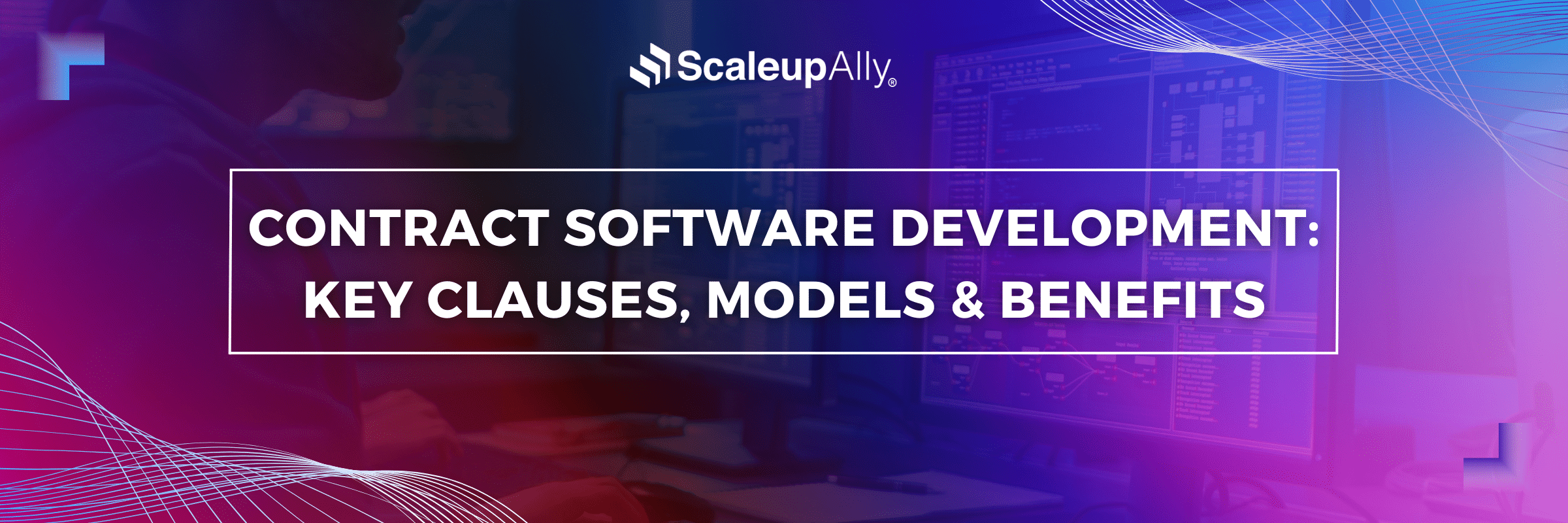
Contract Software Development: Key Clauses, Models & Benefits
Pranay Agrawal | April 28, 2025 , 15 min read
Table Of Content
You’ve spent weeks talking to clients, nodding through meetings about “user journeys,” and your team is itching to start building. Everyone’s excited until the contract lands in your inbox.
The document that was supposed to be a simple formality suddenly feels like a minefield of clauses that could either protect your company or strangle your project before the first line of code is written.
Most developers would rather debug a thousand lines of legacy code than read through legal documents. Yet these papers determine whether your project succeeds or becomes another statistic of failed software ventures.
The difference between successful outsourced projects and expensive failures is in the paragraphs nobody wants to read. While you’re focused on architecture decisions and technical requirements, that contract defines who owns your code, what happens when requirements change, and who’s responsible when things inevitably go sideways.
In this blog, we set out to discuss the benefits, models and key clauses of contract software development. You will also learn how to choose the right model and partner for your next project.
Key Takeaways
- A solid software development contract is your project’s foundation that protects both parties when requirements shift or problems arise.
- The right contract model (Fixed-Price, Time & Materials, Milestone-Based or Retainer) should match your project needs and risk tolerance rather than following industry defaults.
- Contract decisions should reflect your business context, including budget flexibility, requirement clarity and how much control you need over day-to-day development.
- The most important contract clauses should include scope of work, payment terms, timelines, change management, IP rights and dispute resolution. Missing any of these invites trouble.
What is a Software Development Contract?
A software development contract is the rulebook that governs what happens when one company builds code for another.
Contract software development involves a written agreement between the client who needs software built and the development team tasked with building it.
Unlike casual agreements or verbal understandings, a proper software development agreement spells out exactly what will be delivered, when it will happen, how much it will cost, and who owns what when the dust settles. It covers everything from payment schedules to what counts as “done” for specific features.
The document exists because software projects are notoriously slippery. Requirements change, and timelines shift. What seemed simple during initial discussions suddenly requires three additional weeks of work. Without clear boundaries, these shifts can poison relationships and tank projects.
Importance of Contract Software Development
The piece of paper everyone hopes to sign quickly and forget about is your project’s most critical foundation in any software development services engagement. Here’s why putting serious thought into a contract for software development matters more than most people realize:
1. Protection Against Shifting Requirements
When clients suddenly “remember” features they “definitely mentioned before,” your contract becomes your shield. A well-drafted software development contract establishes clear boundaries around project scope, which prevents scope creep.
It forces both parties to think carefully about what’s needed versus what’s merely wanted, and creates mechanisms for handling inevitable changes without derailing the entire project.
2. Intellectual Property Clarity
Who owns the code that gets written? Without proper documentation, this question can trigger expensive legal issues. Your agreement needs to explicitly state whether the client receives full ownership of all code and assets or if the developer retains rights to certain components.
This becomes especially important when using frameworks, libraries, or code snippets that might have their own licensing terms attached.
3. Risk Distribution and Liability Limits
Software fails, deadlines slip, and security breaches happen. A thoughtful contract doesn’t pretend these risks don’t exist. It addresses how responsibility will be distributed when problems arise.
By setting reasonable limits on liability and defining how various scenarios will be handled, both parties can sleep better knowing exactly where they stand if something goes wrong.
4. Relationship Preservation
Perhaps counterintuitively, having tough conversations upfront about potential problems helps maintain healthy working relationships throughout the project. When disagreements inevitably arise, a clear contractual guideline prevents emotions from taking over.
Instead of arguing about who said what three months ago, teams can refer to the agreement and find solutions within established parameters.
Popular Contract Models in Software Development

The contract model you choose shapes everything from daily workflow to final invoices. Here’s how different contract models work:
1. Fixed-Price Contracts
These agreements set a predefined cost for the entire project. The client pays a flat fee regardless of how many hours developers spend building the solution. This model works well for projects with clear, unchanging requirements and predictable timelines.
For clients, fixed-price contracts offer budget certainty. For development teams, they present the challenge of accurate estimation (underestimate, and you eat the costs; overestimate, and your bid might not win the project). This arrangement often shifts most risk to the development team, who must deliver regardless of unexpected complications.
2. Time & Materials (T&M)
In this model, clients pay for actual hours worked plus any material costs incurred. The software development services agreement typically specifies hourly rates for different team members (senior developers, junior coders, designers) and includes a process for tracking and approving time.
T&M contracts provide flexibility to adjust scope as the project progresses, but that flexibility comes with less budget predictability. The arrangement builds on trust. Clients must believe developers aren’t padding hours, while developers need to trust they’ll be paid for all legitimate work.
3. Milestone-Based Contracts
These hybrid models break projects into distinct chunks, each with its own deliverables and payment schedule. Teams receive payment after completing predefined milestones that represent meaningful progress.
This model balances risk between parties while creating natural checkpoints to evaluate progress and make adjustments. For complex projects, milestone contracts allow both sides to commit incrementally rather than gamble everything on a single massive deliverable.
4. Retainer Agreements
Some software development services agreements establish ongoing relationships where clients pay a monthly fee to secure a team’s availability. This model works well for companies that need consistent development support without maintaining an in-house team.
Retainer agreements provide developers with steady income and clients with reliable access to familiar developers who understand their business. The challenge is right-sizing the retainer to match actual needs (too small and developers struggle to meet demands; too large and clients pay for unused capacity).
5. Value-Based Contracts
The newest trend links payment directly to business outcomes. Rather than charging for time or deliverables, developers earn fees based on metrics like revenue generated, customers acquired, or efficiency improved.
These agreements align incentives perfectly. Both parties win when the software delivers business value. However, they require sophisticated measurement systems and mutual trust about what constitutes “value.”
Key Clauses in a Software Development Contract

The difference between a contract that protects both parties and one that causes problems often comes down to these crucial elements. Miss any of these in your agreement and you’re asking for trouble:
1. Scope of Work
This section defines exactly what will be built (the features, functions, and deliverables). The more detailed this description, the fewer disagreements you’ll have later. Smart contracts include both what’s in scope and what’s explicitly excluded, preventing assumptions from either side.
They also establish how changes to scope will be handled, including approval processes and impact assessment on timeline and budget.
2. Payment Terms
More than just the total price, this clause outlines when and how money changes hands. Will you pay upfront, at the end, or at intervals? Are there penalties for late payments? What currencies and payment methods are acceptable?
A solid payment clause protects both parties by creating clarity around financial expectations and consequences.
3. Timeline and Milestones
This section maps the project’s journey from start to finish by establishing deadlines for key deliverables. The best contracts acknowledge reality by including buffer periods and specifying how delays will be handled. They also define what constitutes “done” for each milestone to prevent disagreements about whether deliverables meet expectations.
4. Change Management Process
Requirements will change during development. It’s inevitable. This clause establishes how those changes will be requested, evaluated, approved, and implemented. It should include who can request changes, how impact will be assessed, and what happens to the timeline and budget when changes are approved.
5. Intellectual Property Rights
Who owns the code when the project is complete? This clause specifies whether ownership transfers to the client, remains with the developer, or involves some licensing arrangement. It also addresses pre-existing code, third-party components, and potential future uses of the developed software.
6. Confidentiality Provisions
Both parties typically access sensitive information during a project. This clause defines what constitutes confidential information and how it must be protected. It should specify how long confidentiality obligations extend beyond the project’s completion and what happens if breaches occur.
7. Warranties and Maintenance
What guarantees does the developer make about the software’s quality? How long will they fix bugs after delivery? This section establishes the warranty period and what’s covered within it. It also outlines terms for ongoing maintenance, including response times for critical issues and costs for different support levels.
8. Termination Conditions
Sometimes projects need to end early. This clause defines acceptable reasons for termination by either party and what happens afterward. It should address payment for partially completed work, ownership of code already written, and transition assistance if another developer takes over.
9. Dispute Resolution
When disagreements arise, this section provides a roadmap for resolving them. It might specify mediation requirements before litigation or establish arbitration as the preferred method. The goal is to define a process that avoids expensive court battles while ensuring fair outcomes.
10. Limitation of Liability
This clause caps potential financial exposure for both parties. It typically limits damages to the contract value or some multiple and specifies what kinds of damages can be claimed. Without this protection, disputes over software projects could lead to claims far exceeding the project’s value.
Deciding Which Contract Model to Choose for Software Development
Picking the right contract model is a decision that shapes your entire project. Each option shifts risk and control in different directions, so your choice should match your specific situation rather than following industry defaults.
1. When Project Requirements Are Crystal Clear
If you can define exactly what you need down to the pixel, a fixed-price contract might make sense. This works when you’re building something you’ve built before or when the project scope is naturally limited. The development team takes on the risk of unexpected complications, but you lose flexibility to evolve your vision as the project progresses.
The fixed-price approach works best when your specs are rock-solid and unlikely to change. That new company website with straightforward features? Perfect. That experimental AI-driven platform? Not so much.
2. When Discovery Is Part of The Journey
For projects where requirements will emerge during development, Time & Materials contracts provide breathing room. You’ll pay for actual work performed, which means costs can grow if scope expands, but you won’t be locked into original specifications that no longer make sense.
This model thrives when building innovative products where the path forward becomes clearer as you build. You’ll need strong trust with your development partner and regular checkpoints to ensure progress aligns with expectations.
3. When You Need Control Without Gambling
Milestone-based contracts offer a middle ground (fixed prices for defined chunks of work, with opportunities to adjust between milestones. This reduces risk by breaking the project into manageable pieces that can be evaluated and course-corrected.
This model works particularly well for large projects where complete upfront specification is impossible, but unlimited time and materials feel too risky. Each milestone becomes a natural evaluation point where both sides can reassess priorities.
4. When Relationship Matters More Than Individual Projects
If you’re planning ongoing development work rather than a single project, retainer agreements provide stability for both parties. You secure dedicated developer time each month, while the development team gains predictable revenue.
This works beautifully for businesses needing consistent technical support without maintaining full-time staff. The key is accurately estimating your monthly needs to avoid paying for unused hours or facing resource shortages.
5. When Selecting Based on Business Context
Your own organizational realities should influence your contract choice:
- Tight budget with little flexibility? Fixed-price protects against overruns
- Uncertain about exact needs? Time & Materials allows discovery
- Need to show progress to stakeholders? Milestone-based creates visible wins
- Are Internal approval processes slow? Retainer agreements reduce procurement hassles
The best choice often reflects your company’s risk tolerance, approval processes and how much control you need over day-to-day development decisions.
Getting The Best of Both
Smart companies increasingly combine models (perhaps using Time & Materials during initial discovery phases, then switching to Fixed-Price once requirements stabilize). Or using milestone-based frameworks with mini T&M arrangements within each milestone.
These custom arrangements distribute risk more fairly while providing appropriate structure at each project stage. They require more upfront negotiation but often result in healthier working relationships and better outcomes.
Conclusion
So many million-dollar projects have imploded over vague scope definitions. So many promising partnerships dissolve because nobody thought to specify who owned the code. So many talented teams have been trapped in toxic client relationships because their contract provided no reasonable exit path.
Software development is about relationships. And relationships need boundaries to thrive. Your contract simply consists of those boundaries in written form.
The next time you’re tempted to skim over contract details or accept a template without careful review, remember that the hours you spend getting the agreement right might save you from the months of headaches later. The clause you insist on clarifying might prevent a project-killing dispute. The payment structure you carefully negotiate might be the difference between profit and loss.
Code can be refactored. Poor contracts rarely get second chances. Choose wisely.
Frequently Asked Questions
Q: What is contract software development?
Contract software development is an arrangement where a company hires external developers to build custom software based on specific requirements. The relationship is governed by a formal agreement that defines deliverables, timelines, payment terms and ownership rights for the completed work.
Q: What should a software development contract include?
A comprehensive software development contract should include detailed scope of work, payment terms, timelines, intellectual property rights, confidentiality provisions, change management processes, warranties, maintenance terms, termination conditions and dispute resolution procedures. Each clause protects both parties from misunderstandings and risks.
Q: When should I go for a fixed-price vs T&M model?
Choose fixed-price when your requirements are stable and well-defined, you need budget certainty and scope changes are unlikely. Go with Time & Materials when requirements are evolving, you need flexibility to adjust direction or when the project involves exploration and discovery phases where exact outcomes can’t be predicted.
Related Blogs

IT Outsourcing Costs Explained: Global Rates, Key Influencers & Cost-Saving Tips
Discover what IT outsourcing costs include, key pricing factors, hidden fees, regional rates, and how to pick a cost-effective outsourcing partner.
Pranay Agrawal
Nov 29 ,
13 min read

IT Consulting Rates Per Hour in 2025: Country & Industry Wise
Discover IT consulting rates broken down by experience, specialization, industry, and country. Plan your budget and find the right IT talent for your business needs.
Pranay Agrawal
Nov 25 ,
13 min read

Calculating ROI for Software Development: A Detailed Guide
Discover proven strategies and practical tips to enhance the ROI for software development projects. Learn how to measure success and increase profitability.
Manu Jain
Nov 25 ,
19 min read



